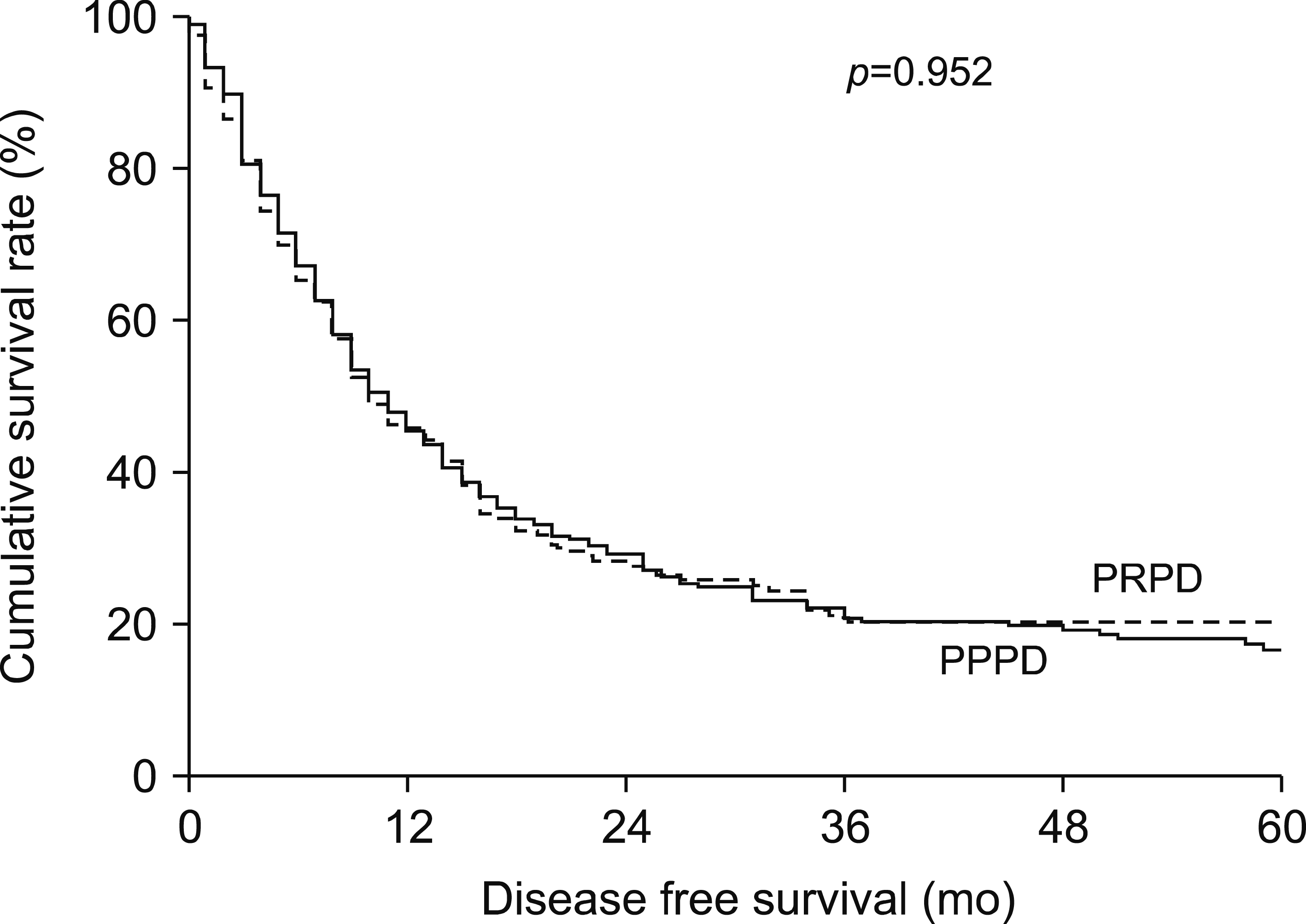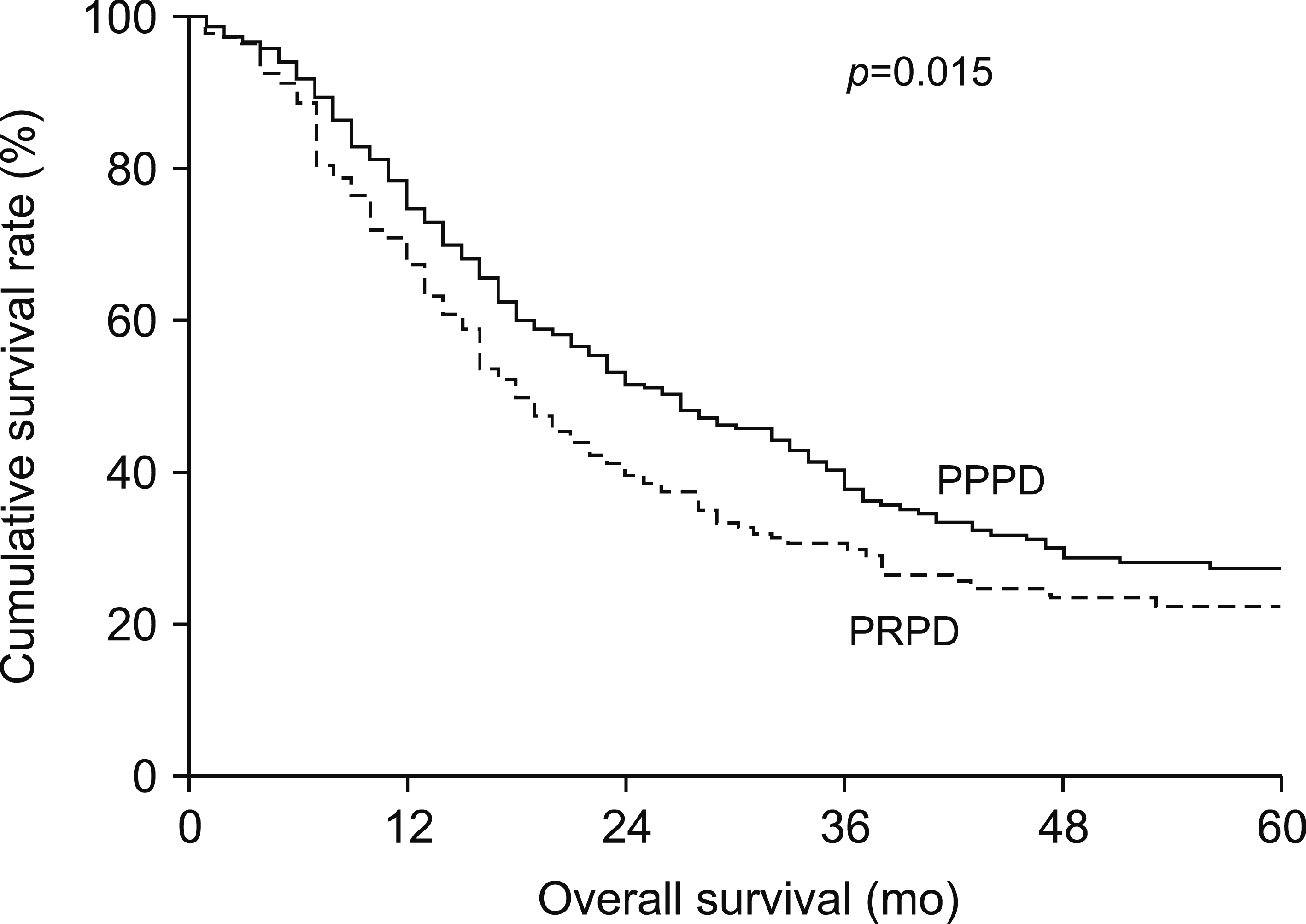1. Iqbal N, Lovegrove RE, Tilney HS, Abraham AT, Bhattacharya S, Tekkis PP, et al. 2008; A comparison of pancreaticoduodenectomy with pylorus preserving pancreaticoduodenectomy: a meta-analysis of 2822 patients. Eur J Surg Oncol. 34:1237–1245. DOI:
10.1016/j.ejso.2007.12.004. PMID:
18242943.

2. Yang C, Wu HS, Chen XL, Wang CY, Gou SM, Xiao J, et al. 2014; Pylorus-preserving versus pylorus-resecting pancreaticoduodenectomy for periampullary and pancreatic carcinoma: a meta-analysis. PLoS One. 9:e90316. DOI:
10.1371/journal.pone.0090316. PMID:
24603478. PMCID:
PMC3946060.

3. Watson K. 1944; Carcinoma of the ampulla of vater successful radical resection. Br J Surg. 31:368–373. DOI:
10.1002/bjs.18003112406.
4. Doyle DJ, Garmon EH. 2020. American Society of Anesthesiologists Classification (ASA Class). StatPearls. StatPearls Publishing LLC;Treasure Island (FL):
5. Verbeke CS, Leitch D, Menon KV, McMahon MJ, Guillou PJ, Anthoney A. 2006; Redefining the R1 resection in pancreatic cancer. Br J Surg. 93:1232–1237. DOI:
10.1002/bjs.5397. PMID:
16804874.

6. Esposito I, Kleeff J, Bergmann F, Reiser C, Herpel E, Friess H, et al. 2008; Most pancreatic cancer resections are R1 resections. Ann Surg Oncol. 15:1651–1660. DOI:
10.1245/s10434-008-9839-8. PMID:
18351300.

7. You Y, Choi DW, Heo JS, Han IW, Choi SH, Jang KT, et al. 2019; Clinical significance of revised microscopic positive resection margin status in ductal adenocarcinoma of pancreatic head. Ann Surg Treat Res. 96:19–26. DOI:
10.4174/astr.2019.96.1.19. PMID:
30603630. PMCID:
PMC6306502.

8. Cong L, Liu Q, Zhang R, Cui M, Zhang X, Gao X, et al. 2018; Tumor size classification of the 8th edition of TNM staging system is superior to that of the 7th edition in predicting the survival outcome of pancreatic cancer patients after radical resection and adjuvant chemotherapy. Sci Rep. 8:10383. DOI:
10.1038/s41598-018-28193-4. PMID:
29991730. PMCID:
PMC6039534.

9. Dindo D, Demartines N, Clavien PA. 2004; Classification of surgical complications: a new proposal with evaluation in a cohort of 6336 patients and results of a survey. Ann Surg. 240:205–213. DOI:
10.1097/01.sla.0000133083.54934.ae. PMID:
15273542. PMCID:
PMC1360123.
10. Bassi C, Marchegiani G, Dervenis C, Sarr M, Abu Hilal M, Adham M, et al. 2017; The 2016 update of the International Study Group (ISGPS) definition and grading of postoperative pancreatic fistula: 11 years after. Surgery. 161:584–591. DOI:
10.1016/j.surg.2016.11.014. PMID:
28040257.
11. Wente MN, Bassi C, Dervenis C, Fingerhut A, Gouma DJ, Izbicki JR, et al. 2007; Delayed gastric emptying (DGE) after pancreatic surgery: a suggested definition by the International Study Group of Pancreatic Surgery (ISGPS). Surgery. 142:761–768. DOI:
10.1016/j.surg.2007.05.005. PMID:
17981197.

12. Chen QJ, He ZQ, Yang Y, Zhang YS, Chen XL, Yang HJ, et al. 2015; Is there comparable morbidity in pylorus-preserving and pylorus- resecting pancreaticoduodenectomy? A meta-analysis. J Huazhong Univ Sci Technolog Med Sci. 35:793–800. DOI:
10.1007/s11596-015-1509-z. PMID:
26670427.
13. Lin PW, Lin YJ. 1999; Prospective randomized comparison between pylorus-preserving and standard pancreaticoduodenectomy. Br J Surg. 86:603–607. DOI:
10.1046/j.1365-2168.1999.01074.x. PMID:
10361177.

14. Seiler CA, Wagner M, Sadowski C, Kulli C, Büchler MW. 2000; Randomized prospective trial of pylorus-preserving vs. classic duodenopancreatectomy (Whipple procedure): initial clinical results. J Gastrointest Surg. 4:443–452. DOI:
10.1016/S1091-255X(00)80084-0. PMID:
11077317.

15. Tran KT, Smeenk HG, van Eijck CH, Kazemier G, Hop WC, Greve JW, et al. 2004; Pylorus preserving pancreaticoduodenectomy versus standard Whipple procedure: a prospective, randomized, multicenter analysis of 170 patients with pancreatic and periampullary tumors. Ann Surg. 240:738–745. DOI:
10.1097/01.sla.0000143248.71964.29. PMID:
15492552. PMCID:
PMC1356476.
16. Seiler CA, Wagner M, Bachmann T, Redaelli CA, Schmied B, Uhl W, et al. 2005; Randomized clinical trial of pylorus-preserving duodenopancreatectomy versus classical Whipple resection-long term results. Br J Surg. 92:547–556. DOI:
10.1002/bjs.4881. PMID:
15800958.

17. Lin PW, Shan YS, Lin YJ, Hung CJ. 2005; Pancreaticoduodenectomy for pancreatic head cancer: PPPD versus Whipple procedure. Hepatogastroenterology. 52:1601–1604. PMID:
16201125.
18. Diener MK, Knaebel HP, Heukaufer C, Antes G, Büchler MW, Seiler CM. 2007; A systematic review and meta-analysis of pylorus-preserving versus classical pancreaticoduodenectomy for surgical treatment of periampullary and pancreatic carcinoma. Ann Surg. 245:187–200. DOI:
10.1097/01.sla.0000242711.74502.a9. PMID:
17245171. PMCID:
PMC1876989.

19. Eeson G, Chang N, McGahan CE, Khurshed F, Buczkowski AK, Scudamore CH, et al. 2012; Determination of factors predictive of outcome for patients undergoing a pancreaticoduodenectomy of pancreatic head ductal adenocarcinomas. HPB (Oxford). 14:310–316. DOI:
10.1111/j.1477-2574.2012.00448.x. PMID:
22487068. PMCID:
PMC3384850.

20. Gouma DJ, van Geenen RC, van Gulik TM, de Haan RJ, de Wit LT, Busch OR, et al. 2000; Rates of complications and death after pancreaticoduodenectomy: risk factors and the impact of hospital volume. Ann Surg. 232:786–795. DOI:
10.1097/00000658-200012000-00007. PMID:
11088073. PMCID:
PMC1421271.

21. El Nakeeb A, Salah T, Sultan A, El Hemaly M, Askr W, Ezzat H, et al. 2013; Pancreatic anastomotic leakage after pancreaticoduodenectomy. Risk factors, clinical predictors, and management (single center experience). World J Surg. 37:1405–1418. DOI:
10.1007/s00268-013-1998-5. PMID:
23494109.

22. Klaiber U, Probst P, Hüttner FJ, Bruckner T, Strobel O, Diener MK, et al. 2020; Randomized trial of pylorus-preserving vs. pylorus-resecting pancreatoduodenectomy: long-term morbidity and quality of life. J Gastrointest Surg. 24:341–352. DOI:
10.1007/s11605-018-04102-y. PMID:
30671796.

23. Khadka R, Tian W, Hao X, Koirala R. 2018; Risk factor, early diagnosis and overall survival on outcome of association between pancreatic cancer and diabetes mellitus: changes and advances, a review. Int J Surg. 52:342–346. DOI:
10.1016/j.ijsu.2018.02.058. PMID:
29535016.

24. Kwon JH, Kim SC, Shim IK, Song KB, Lee JH, Hwang DW, et al. 2015; Factors affecting the development of diabetes mellitus after pancreatic resection. Pancreas. 44:1296–1303. DOI:
10.1097/MPA.0000000000000404. PMID:
26390413.

25. White MA, Agle SC, Fuhr HM, Mehaffey JH, Waibel BH, Zervos EE. 2011; Impact of pancreatic cancer and subsequent resection on glycemic control in diabetic and nondiabetic patients. Am Surg. 77:1032–1037. DOI:
10.1177/000313481107700823. PMID:
21944519.

26. Wang F, Gupta S, Holly EA. 2006; Diabetes mellitus and pancreatic cancer in a population-based case-control study in the San Francisco Bay Area, California. Cancer Epidemiol Biomarkers Prev. 15:1458–1463. DOI:
10.1158/1055-9965.EPI-06-0188. PMID:
16896032.

27. Fogar P, Pasquali C, Basso D, Sperti C, Panozzo MP, Tessari G, et al. 1994; Diabetes mellitus in pancreatic cancer follow-up. Anticancer Res. 14:2827–2830. PMID:
7532931.




 PDF
PDF Citation
Citation Print
Print





 XML Download
XML Download